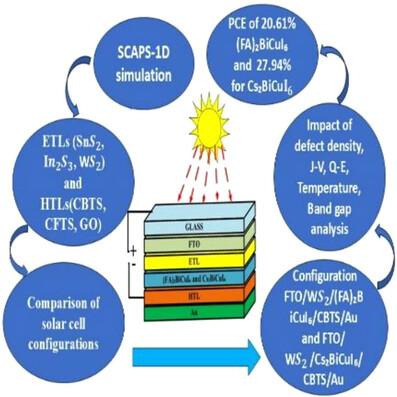Performance-Optimized Lead-Free Double Perovskites: A Comparative Study of (FA)2BiCuI6 and Cs2BiCuI6 Solar Cells
IF 2.9
4区 工程技术
Q1 MULTIDISCIPLINARY SCIENCES
引用次数: 0
Abstract
The toxicity and instability of lead-based perovskite solar cells (PSCs) have intensified the need for eco-friendly alternatives that have driven research into lead-free options such as (FA)2BiCuI6 and Cs2BiCuI6-based double perovskites. An extensive computational analysis and performance optimization are executed via SCAPS-1D simulations. The photovoltaic performance of (FA)2BiCuI6 and Cs2BiCuI6-based solar cells has been evaluated using different electron and hole transport layer combinations. In this work, the photovoltaic performance optimization has been simulated across different HTL (CBTS, CFTS, GO) and ETL (SnS2, In2S33, WS2) combinations in the proposed device design to optimize power conversion efficiency. According to simulations, the optimized FTO/WS2/Cs2BiCuI6/CBTS/Au architecture achieves a PCE of 27.57%, significantly higher than the 20.32% efficiency of the FTO/WS2/(FA)2BiCuI6/CBTS/Au design. The implementation of bandgap grading in absorber layers boosts cell efficiencies to 20.61% and 27.94% by suppressing interfacial recombination. The investigation has been further analyzed for several critical parameters, focusing on absorber defect concentrations, generation-recombination rates, and temperature effects. These findings have driven significant progress in eco-friendly double perovskite solar cells (PSCs), improving efficiency and paving the way for widespread adoption.

性能优化的双钙钛矿:(FA)2BiCuI6和Cs2BiCuI6太阳能电池的比较研究
铅基钙钛矿太阳能电池(PSCs)的毒性和不稳定性加剧了对环保替代品的需求,这推动了对无铅选择的研究,如(FA)2BiCuI6和cs2bicui6基双钙钛矿。通过SCAPS-1D模拟进行了广泛的计算分析和性能优化。采用不同的电子和空穴传输层组合,对(FA)2BiCuI6和cs2bicui6基太阳能电池的光伏性能进行了评价。在这项工作中,在提出的器件设计中,模拟了不同HTL (CBTS, CFTS, GO)和ETL (SnS2, In2S33, WS2)组合的光伏性能优化,以优化功率转换效率。仿真结果表明,优化后的FTO/WS2/Cs2BiCuI6/CBTS/Au结构的PCE为27.57%,显著高于FTO/WS2/(FA)2BiCuI6/CBTS/Au结构的20.32%。在吸收层中实现带隙分级,通过抑制界面复合,将电池效率提高到20.61%和27.94%。研究进一步分析了几个关键参数,重点是吸收剂缺陷浓度、生成-重组率和温度效应。这些发现推动了环保双钙钛矿太阳能电池(PSCs)的重大进展,提高了效率,为广泛采用铺平了道路。
本文章由计算机程序翻译,如有差异,请以英文原文为准。
求助全文
约1分钟内获得全文
求助全文
来源期刊

Advanced Theory and Simulations
Multidisciplinary-Multidisciplinary
CiteScore
5.50
自引率
3.00%
发文量
221
期刊介绍:
Advanced Theory and Simulations is an interdisciplinary, international, English-language journal that publishes high-quality scientific results focusing on the development and application of theoretical methods, modeling and simulation approaches in all natural science and medicine areas, including:
materials, chemistry, condensed matter physics
engineering, energy
life science, biology, medicine
atmospheric/environmental science, climate science
planetary science, astronomy, cosmology
method development, numerical methods, statistics
 求助内容:
求助内容: 应助结果提醒方式:
应助结果提醒方式:


